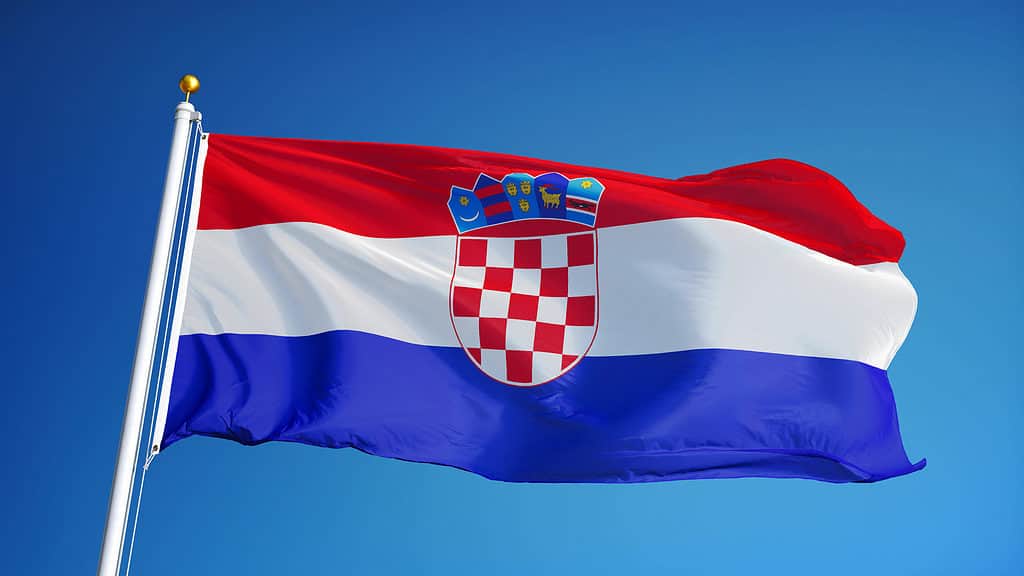Croatia, or officially the Republic of Croatia, is a European country which lies next to the Adriatic Sea. Although Croatia is today an independent country it has existed in various other forms as part of other nations, including Hungary and Yugoslavia. The flag of Croatia has changed many times over the years to reflect the changing status of the country, with Croatia even having to endure a war of independence to finally gain its freedom.
Founding of Croatia
Croatia is a country that has long been inhabited. There are even Neanderthal fossils dating back to the Paleolithic period found in the northern region. Croatia entered into a union with Hungary in 1102. Despite other adversities, this union existed until 1941. In 1941, Croatia became the Independent State of Croatia following the invasion of the Kingdom of Yugoslavia by the Axis powers (the military coalition that initiated World War II).
Following this there was a resistance movement by the Croatian Partisans, also known as the National Liberation Movement, which led to the country becoming the Socialist Republic of Croatia. This was one of the founding members of the eventual Socialist Federal Republic of Yugoslavia.
Croatia remained part of Yugoslavia until it declared independence in 1991 following rising tensions. However, the country then became embroiled in a four-year war of independence as it fought for its freedom. This conflict, the Homeland War, was a battle between the Croatian government and the Yugoslav People’s Army. The Yugoslav People’s Army tried to prevent Croatia from separating from Yugoslavia by attempting to occupy the entire country. However, after four long years Croatia managed to successfully win the war and their independence. Unfortunately, the war cost the lives of 20,000 people, displaced many more, and ruined approximately 25% of the country’s economy. Despite facing many challenges as a result, Croatia has managed to rebuild itself to become the country that we know today.
Characteristics of Croatia
Croatia is a small yet diverse country located in the northwestern region of the Balkan Peninsula. It has three main regions: the Pannonian and para-Pannonian plains in the north and north east; the central mountain belt which includes part of the Dinaric Alps; and the Croatian littoral which is comprised of the Dalmatian coast and the Istria Peninsula. Croatia mostly has a warm and sunny climate. However, the coldest regions are in the mountains where there is frequently snow at elevations above 3,900 feet. As it has so many different habitats it’s not surprising that Croatia is home to more than 37,000 species of plants and animals. In fact, there are more than 1,000 species that are endemic to the country.
Although Croatian is the official language of Croatia, more than 75% of people in the country can speak a second language, with almost 50% speaking English. The country has a high-income economy, with the service, industrial, and agricultural sectors being the largest. Tourism is also important to Croatia, with the country ranked amongst the top 20 tourist destinations.
History and Symbolism of the Flag of Croatia

The flag of Croatia features a red and white checkered shield, which represents the original flag of the Kingdom of Croatia.
©Railway fx/Shutterstock.com
Croatia has had many different flags in its long history. Today’s flag was adopted in December 1990, 10 months before the country declared independence. It is a tricolor flag which consists of three horizontal stripes of red, white, and blue. In the center of the flag is a shield in red and white checks. Above it sits a crown made from Croatian shields.
The red, white, and blue tricolor pattern originated on Croatia’s flags in 1848. These shades are the Pan-Slavic colors, which widely symbolize romantic nationalism. Croatia is not the only country to use the Pan-Slavic colors on their flag, with other countries including the Czech Republic, Slovakia, and Slovenia.
Today, the larger central shield on the flag has red and white checks. This represents the original flag of the Kingdom of Croatia that existed between 925 and 1102. However, the crown above symbolizes unity. Five smaller shields make up the crown, with each shield depicting the ancient coat of arms of Croatia, Dubrovnik, Dalmatia, Istria, and Slavonia.
Previous Flags of Croatia
The Pan-Slavic tricolors have since formed the basis for most of Croatia’s flags from 1848 right up to the present day. In 1848, the flag also had a red and white checked shield with a modern crown above it. However, only a short while later, Croatia changed the flag’s shield to the triune coat of arms. This flag was later banned between 1852 and 1860. At this point, the flag became simply two horizontal bars of red and white.
The tricolor flag was again made legal in 1868. It displayed a coat of arms and the red and white shield until the end of the Second World War and the formation of the Socialist Republic of Croatia. At this point, the shield changed to a five pointed red star. This star, and later a slightly bigger gold-rimmed version, remained on the flag until 1990. After this, the red and white shield once again made a come back to form the flag that flies in Croatia today.
Up Next
- The Flag of Senegal: History, Meaning, and Symbolism
- The Flag of Australia: History, Meaning, and Symbolism
- 3 Countries with Animals on Their Flags, and Their Meaning
The photo featured at the top of this post is © Osman Bugra Nuvasil/Shutterstock.com
Sources
- Wikipedia, Available here: https://en.wikipedia.org/wiki/Flag_of_Croatia
- Wikipedia, Available here: https://en.wikipedia.org/wiki/Croatian_War_of_Independence
- Britannica, Available here: https://www.britannica.com/place/Croatia
Thank you for reading! Have some feedback for us? Contact the AZ Animals editorial team.






